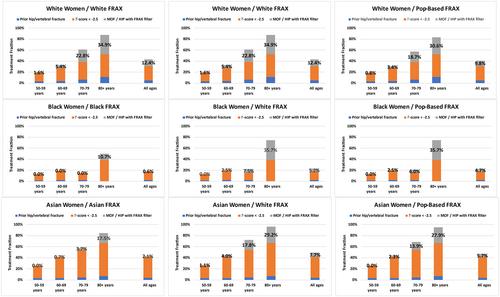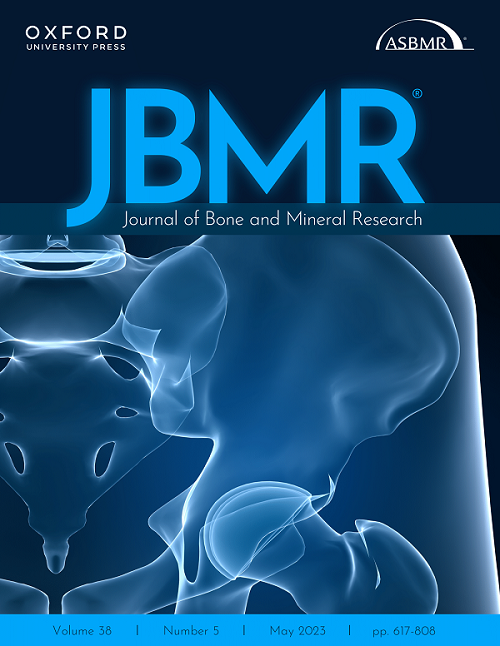William D Leslie, for the ASBMR Task Force on Clinical Algorithms for Fracture Risk
下载PDF
{"title":"种族/民族对美国FRAX计算和治疗资格的影响:一项基于登记的研究。","authors":"William D Leslie, for the ASBMR Task Force on Clinical Algorithms for Fracture Risk","doi":"10.1002/jbmr.4896","DOIUrl":null,"url":null,"abstract":"<p>Since 2008. the United States has had four race/ethnic fracture risk assessment tool (FRAX) calculators: White (“Caucasian”), Black, Asian, and Hispanic. The American Society for Bone and Mineral Research Task Force on Clinical Algorithms for Fracture Risk has been examining the implications of retaining race/ethnicity in the US FRAX calculators. To inform the Task Force, we computed FRAX scores according to each US calculator in 114,942 White, 485 Black, and 2816 Asian women (self-reported race/ethnicity) aged 50 years and older. We estimated treatment qualification based upon FRAX thresholds (3% for hip fracture, 20% for major osteoporotic fracture [MOF]). Finally, we examined measures for a hypothetical population-based FRAX calculator derived as the weighted mean for the US population based upon US Census Bureau statistics. With identical inputs, the highest FRAX measurements were found with the White FRAX calculator, lowest measurements with the Black calculator, and intermediate measurements for the Asian and Hispanic calculators. The percentage of women with FRAX scores exceeding the hip fracture treatment threshold was 32.0% for White, 1.9% for Black, and 19.7% for Asian women; the MOF treatment threshold was exceeded for 14.9% of White, 0.0% of Black, and 3.5% of Asian women. Disparities in treatment qualification were reduced after considering additional criteria (fracture history and dual-energy X-ray absorptiometry [DXA] <i>T</i>-score −2.5 or lower). When fracture risk was recalculated for non-White women using the White FRAX calculator, mean values for Asian women slightly exceeded those for White women but for Black women remained substantially below those for White women. When using a single population–based FRAX calculator, the mean probability of fracture and treatment qualification increased for non-White women across the age range. In summary, use of a single population–based FRAX calculator, rather than existing US race/ethnic FRAX calculators, will reduce differences in treatment qualification and may ultimately enhance equity and access to osteoporosis treatment. © 2023 The Authors. <i>Journal of Bone and Mineral Research</i> published by Wiley Periodicals LLC on behalf of American Society for Bone and Mineral Research (ASBMR).</p>","PeriodicalId":185,"journal":{"name":"Journal of Bone and Mineral Research","volume":"38 12","pages":"1742-1748"},"PeriodicalIF":5.1000,"publicationDate":"2023-08-07","publicationTypes":"Journal Article","fieldsOfStudy":null,"isOpenAccess":false,"openAccessPdf":"https://onlinelibrary.wiley.com/doi/epdf/10.1002/jbmr.4896","citationCount":"0","resultStr":"{\"title\":\"Effect of Race/Ethnicity on United States FRAX Calculations and Treatment Qualification: A Registry-Based Study\",\"authors\":\"William D Leslie, for the ASBMR Task Force on Clinical Algorithms for Fracture Risk\",\"doi\":\"10.1002/jbmr.4896\",\"DOIUrl\":null,\"url\":null,\"abstract\":\"<p>Since 2008. the United States has had four race/ethnic fracture risk assessment tool (FRAX) calculators: White (“Caucasian”), Black, Asian, and Hispanic. The American Society for Bone and Mineral Research Task Force on Clinical Algorithms for Fracture Risk has been examining the implications of retaining race/ethnicity in the US FRAX calculators. To inform the Task Force, we computed FRAX scores according to each US calculator in 114,942 White, 485 Black, and 2816 Asian women (self-reported race/ethnicity) aged 50 years and older. We estimated treatment qualification based upon FRAX thresholds (3% for hip fracture, 20% for major osteoporotic fracture [MOF]). Finally, we examined measures for a hypothetical population-based FRAX calculator derived as the weighted mean for the US population based upon US Census Bureau statistics. With identical inputs, the highest FRAX measurements were found with the White FRAX calculator, lowest measurements with the Black calculator, and intermediate measurements for the Asian and Hispanic calculators. The percentage of women with FRAX scores exceeding the hip fracture treatment threshold was 32.0% for White, 1.9% for Black, and 19.7% for Asian women; the MOF treatment threshold was exceeded for 14.9% of White, 0.0% of Black, and 3.5% of Asian women. Disparities in treatment qualification were reduced after considering additional criteria (fracture history and dual-energy X-ray absorptiometry [DXA] <i>T</i>-score −2.5 or lower). When fracture risk was recalculated for non-White women using the White FRAX calculator, mean values for Asian women slightly exceeded those for White women but for Black women remained substantially below those for White women. When using a single population–based FRAX calculator, the mean probability of fracture and treatment qualification increased for non-White women across the age range. In summary, use of a single population–based FRAX calculator, rather than existing US race/ethnic FRAX calculators, will reduce differences in treatment qualification and may ultimately enhance equity and access to osteoporosis treatment. © 2023 The Authors. <i>Journal of Bone and Mineral Research</i> published by Wiley Periodicals LLC on behalf of American Society for Bone and Mineral Research (ASBMR).</p>\",\"PeriodicalId\":185,\"journal\":{\"name\":\"Journal of Bone and Mineral Research\",\"volume\":\"38 12\",\"pages\":\"1742-1748\"},\"PeriodicalIF\":5.1000,\"publicationDate\":\"2023-08-07\",\"publicationTypes\":\"Journal Article\",\"fieldsOfStudy\":null,\"isOpenAccess\":false,\"openAccessPdf\":\"https://onlinelibrary.wiley.com/doi/epdf/10.1002/jbmr.4896\",\"citationCount\":\"0\",\"resultStr\":null,\"platform\":\"Semanticscholar\",\"paperid\":null,\"PeriodicalName\":\"Journal of Bone and Mineral Research\",\"FirstCategoryId\":\"3\",\"ListUrlMain\":\"https://onlinelibrary.wiley.com/doi/10.1002/jbmr.4896\",\"RegionNum\":1,\"RegionCategory\":\"医学\",\"ArticlePicture\":[],\"TitleCN\":null,\"AbstractTextCN\":null,\"PMCID\":null,\"EPubDate\":\"\",\"PubModel\":\"\",\"JCR\":\"Q1\",\"JCRName\":\"ENDOCRINOLOGY & METABOLISM\",\"Score\":null,\"Total\":0}","platform":"Semanticscholar","paperid":null,"PeriodicalName":"Journal of Bone and Mineral Research","FirstCategoryId":"3","ListUrlMain":"https://onlinelibrary.wiley.com/doi/10.1002/jbmr.4896","RegionNum":1,"RegionCategory":"医学","ArticlePicture":[],"TitleCN":null,"AbstractTextCN":null,"PMCID":null,"EPubDate":"","PubModel":"","JCR":"Q1","JCRName":"ENDOCRINOLOGY & METABOLISM","Score":null,"Total":0}
引用次数: 0
引用
批量引用


 求助内容:
求助内容: 应助结果提醒方式:
应助结果提醒方式:


